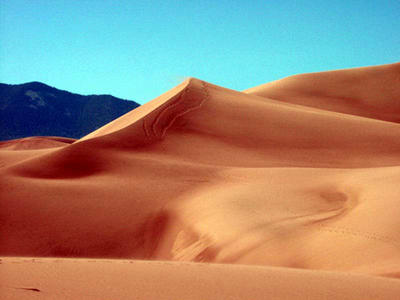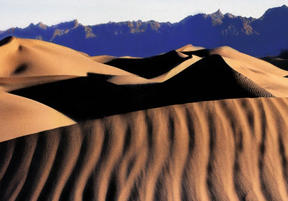
When he heard them in the
After generations of mystical interpretations, researchers are finally closing in on a scientific explanation for the acoustics of sand. They now agree that the phenomenon of noisemaking sand is made possible by the action of displacement, which produces musical instrument-like vibrations in sand grains. The exact recipe for noisy sands is still only wholly known in Mother Nature's kitchen, but here are the necessary ingredients and right conditions experts have deduced so far for the two main varieties.
Listen to croaking sand
Unlike the haunting so-called booming sands that Marco Polo and others discovered
among the isolated dunes of storied deserts, the noises sand makes are not always mellifluous. Some relatively ordinary beach sands on the shores of oceans, lakes, and rivers make mundane noises. Generally called squeaking sands, these common cousins of booming sands work like this:
By stepping on a stretch of beach or dune, moving across it with your hand, or poking it with a stick, pencil, or other such object, you can, given the right kind of sand (see ingredient list at left), produce peals of sound at very high frequencies—between 500 and 2,500 hertz—lasting less than a quarter of a second. These bursts result from the friction produced when the pressure of applied weight causes surface sand to displace and rapidly rub against the surrounding sand. The kind of sound produced depends on the texture and size of the sand grains.
Listen to booming sand
Only around 30 "booming" dunes are known worldwide—in deserts and on beaches in
Booming sand starts with a dune made of sand that has traveled long distances from its original source. The sand's lengthy, windy journey means that grains deposited on the surface of the dune are extremely round, smooth, and uniform.
Next, a desert rainstorm must take place, washing dust and other foreign particles from among the surface grains. The topmost sand must then dry out over a period of weeks while the sand beneath remains relatively moist.
In squeaking sand, noise-producing displacement can occur merely by stepping on the sand with your foot. Booming sand requires the shearing action of a sand avalanche. Avalanches can begin only after a dry desert sand dune has built up to an angle of about 35 degrees and only when a sufficient amount of wind provides enough force to begin the avalanche.
During an avalanche, surface layers of dry sand slip over the lower layers of the dune. Individual grains of loose surface sand bounce up and down over the compacted lower layers of the dune, which have a higher moisture content. The interaction between the upper- and lower-layer sand grains produces vibrations that make sound, much as a violin string does as a bow passes over it.
Booming sand makes loud, low-frequency sounds of 50 to 300 hertz. During a large avalanche, the booming can be heard more than six miles away and standing near its locus can be deafening.
You can watch this seven minute PBS video and be wowed by the sound of sand.
Wow Sand that sings! Too Cool and just another reason to keep walking this big Weird World of ours!
I’m Average Joe


No comments:
Post a Comment